COLLECTIVE EXHIBITION OF IBEROAMERICAN ART AT LA COMETA
By Álvaro de Benito
The Madrid branch of La Cometa gallery presents during July the work of eight of its Ibero-American artists in a group show that delves into different languages and techniques, from ceramics to painting, and also includes dialogues with architecture and other productions. Three of those represented come from Spain, while of the five American representatives, four are Colombian and one is Cuban, which brings a representative vision of the gallery's artistic proposal closer to the spectator.
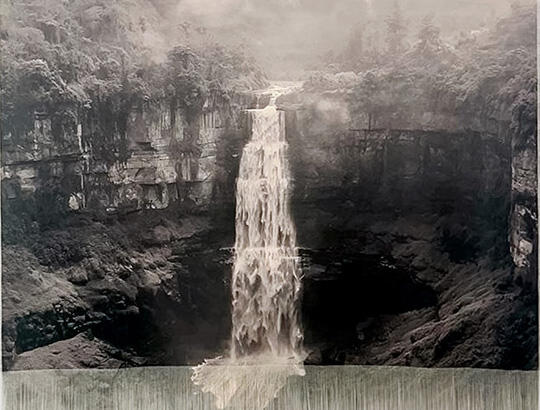
Juan Baraja (Toledo, Spain, 1984) gives a look at everyday architecture and the spaces it creates. His photographs capture these places, but above all he invites us to observe their detail and subtlety, regardless of their nature. Mercedes Lara (Daimiel, Spain, 1967) proposes a representation of the environment of her hometown through the use of changing shapes and color to generate the reflection of the landscapes themselves and the material sensation of the seasons of the year that mark the daily life. Luisa Pastor (Alicante, Spain, 1977) builds worlds through fragments that invite reflection to work the analysis and critical look towards the materialism that invades contemporary society.
The ceramic works of Nicolás Bonilla (Bogotá, Colombia, 1984) offer a wide range of possibilities to work on the concepts of nature. For his part, Adam Goldstein (Bogota, Colombia, 1989) vindicates the most academic abstraction in his production focused on the relationship between light and color. Ana González (Bogota, Colombia, 1974) bets on beauty as a central aesthetic element represented through her sculptural interventions and advocates collaboration as an essential part of creation. Yosman Botero (Cúcuta, Colombia, 1983) draws from magical realism to convey feelings of uneasiness about the essential and the apparent reality in which we live, generating the need to get something more through the intensive look at the hidden. Rachel Valdés (Havana, Cuba, 1990) closes the American list of this collective exhibition with her three-dimensional work in diverse techniques that invites to reflect and contemplate the relationship between work and spectator.
Group exhibition: Juan Baraja, Nicolás Bonilla, Adam Goldstein, Ana González, Mercedes Lara, Alberto Lezaca, Luisa Pastor, Rachel Valdés can be seen until the end of the month at La Cometa, Calle de San Lorenzo, 11, Madrid, Spain.
Related Topics
May interest you
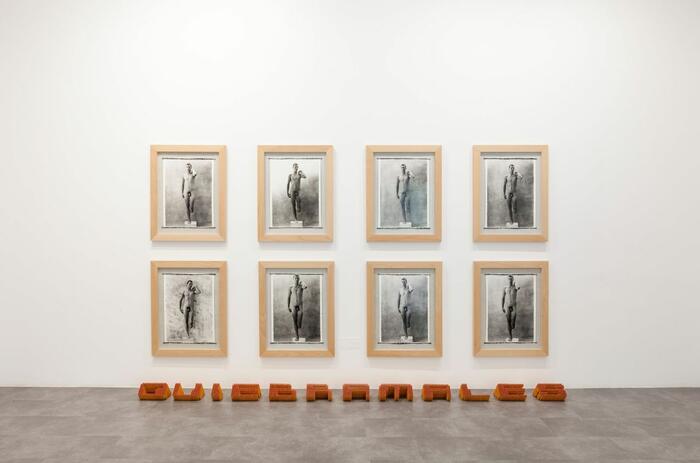
Two decades after Miguel Ángel Rojas (1946, Bogotá, Colombia) conceptualized in his project David Quiebramales his denunciation of violence and the use of education as the most efficient vehicle towards a catharsis for those who suffer it, the Madrid headquarters of La Cometa revisits his most emblematic work and reinterprets it as the framework for a kind of thematic retrospective. This commemoration of that first David Quiebramales reinforces a view that is still difficult to overcome and that, even today, serves to trace those harmful social dynamics that are created between society and war, the institutional and the political systems.
TOWARDS MIGUEL ÁNGEL ROJAS' QUIEBRAMALES
Two decades after Miguel Ángel Rojas (1946, Bogotá, Colombia) conceptualized in his project David Quiebramales his denunciation of violence and the use of education as the most efficient vehicle towards a catharsis for those who suffer it, the Madrid headquarters of La Cometa revisits his most emblematic work and reinterprets it as the framework for a kind of thematic retrospective. This commemoration of that first David Quiebramales reinforces a view that is still difficult to overcome and that, even today, serves to trace those harmful social dynamics that are created between society and war, the institutional and the political systems.

Two decades after Miguel Ángel Rojas (1946, Bogotá, Colombia) conceptualized in his project David Quiebramales his denunciation of violence and the use of education as the most efficient vehicle towards a catharsis for those who suffer it, the Madrid headquarters of La Cometa revisits his most emblematic work and reinterprets it as the framework for a kind of thematic retrospective. This commemoration of that first David Quiebramales reinforces a view that is still difficult to overcome and that, even today, serves to trace those harmful social dynamics that are created between society and war, the institutional and the political systems.
TOWARDS MIGUEL ÁNGEL ROJAS' QUIEBRAMALES
Two decades after Miguel Ángel Rojas (1946, Bogotá, Colombia) conceptualized in his project David Quiebramales his denunciation of violence and the use of education as the most efficient vehicle towards a catharsis for those who suffer it, the Madrid headquarters of La Cometa revisits his most emblematic work and reinterprets it as the framework for a kind of thematic retrospective. This commemoration of that first David Quiebramales reinforces a view that is still difficult to overcome and that, even today, serves to trace those harmful social dynamics that are created between society and war, the institutional and the political systems.
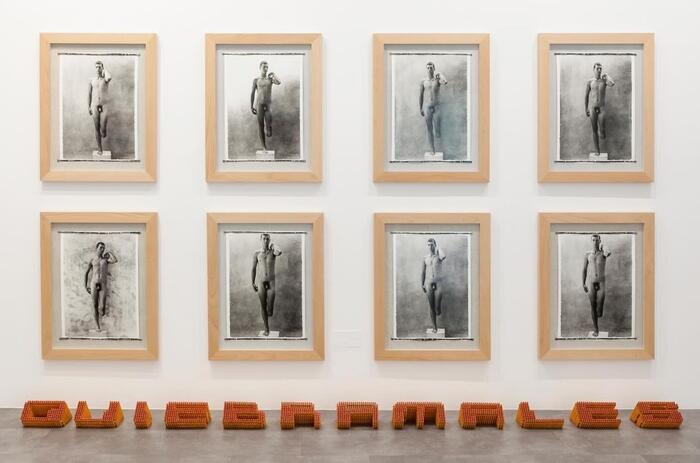
Quiebramales commemorates the twentieth anniversary of the conception of the David Quiebramales project. The exhibition at La Cometa gallery revisits the biopolitics that traverse the bodies affected by war, the structures that build (and destroy) a society, and education as a path to social justice.

Nuevos vecinos (New neighbours) seeks to set up a dialogue between the last two projects by Adrián Gaitán: Para los tiempos que corren, presented in the XI version of the Luis Caballero award in 2022 and Nobleza Obliga, carried out in NC arte in 2021.
NUEVOS VECINOS. ADRIAN GAITÁN’S EXHIBITION AT LA COMETA
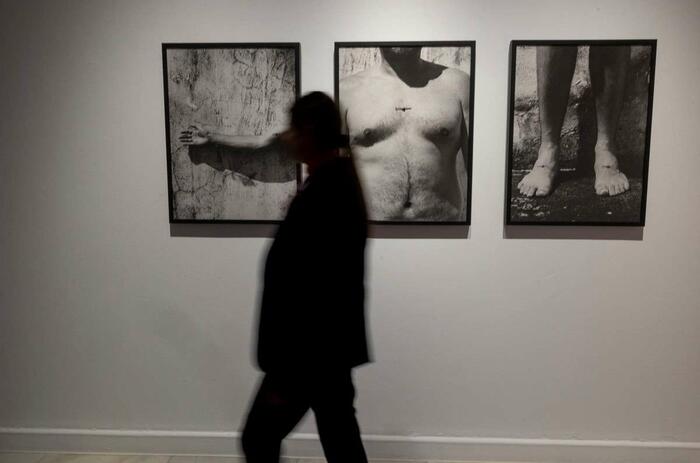
Concrete Wounds/Herida concreta is the exhibition that the Canary Islands' Centro Atlántico de Arte Moderno (CAAM) is dedicating to Karlo Andrei Ibarra (San Juan, Puerto Rico, 1982), one of the most promising and internationally renowned names of the Puerto Rican art scene.
THE POLITICAL AND SOCIAL MEANINGS OF KARLO ANDREI IBARRA AT CAAM
Concrete Wounds/Herida concreta is the exhibition that the Canary Islands' Centro Atlántico de Arte Moderno (CAAM) is dedicating to Karlo Andrei Ibarra (San Juan, Puerto Rico, 1982), one of the most promising and internationally renowned names of the Puerto Rican art scene.
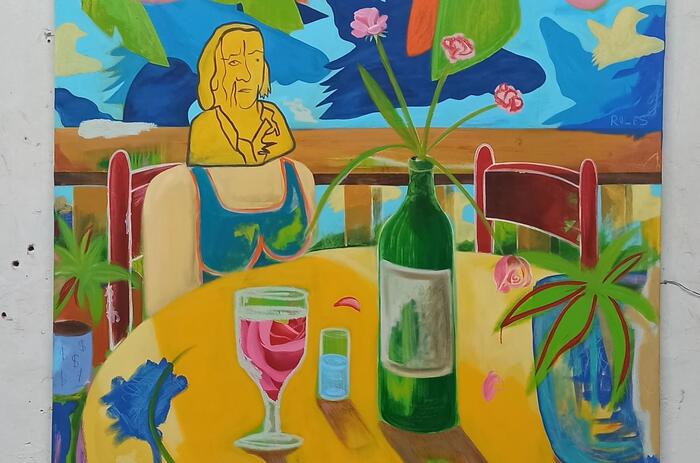
The birth of a new collective is always good news, and it is so for several reasons. Firstly, because of the existence of collective dynamics that bring together different points of view and, second, because, in a didactic way, it contributes to illustrate and understand the current cartographies of art. For the Revolú collective, formed by Andrés Meléndez (San Juan, Puerto Rico, 1996), Miguel Ángel Feba (San Juan, Puerto Rico, 1994) and Marcos Daniel Vicéns (Bayamón, Puerto Rico, 1996), their first exhibition experience is the result of an artistic residency in which, almost blindly, they have been able to build those specific ties to start from the individual and reach the group identity.
GENESIS AND BORICUA RESONANCES IN REVOLÚ
The birth of a new collective is always good news, and it is so for several reasons. Firstly, because of the existence of collective dynamics that bring together different points of view and, second, because, in a didactic way, it contributes to illustrate and understand the current cartographies of art. For the Revolú collective, formed by Andrés Meléndez (San Juan, Puerto Rico, 1996), Miguel Ángel Feba (San Juan, Puerto Rico, 1994) and Marcos Daniel Vicéns (Bayamón, Puerto Rico, 1996), their first exhibition experience is the result of an artistic residency in which, almost blindly, they have been able to build those specific ties to start from the individual and reach the group identity.
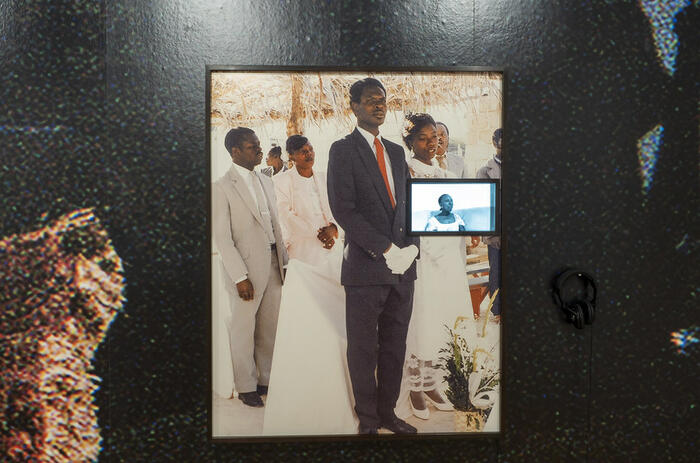
Widline Cadet (Pétion-Ville, Haiti, 1992) brings together in her life experience several of the aspects and themes that, perhaps, have inspired more production among all those curatorial lines with more presence. Her biography, constructed through childhood memories, the environment of a generation and a country marked by its own strong culture or the phenomena of emigration, constitutes the framework in which the photographer develops the practical integrity of her work.
MEMORY AND DIASPORA IN WIDLINE CADET
Widline Cadet (Pétion-Ville, Haiti, 1992) brings together in her life experience several of the aspects and themes that, perhaps, have inspired more production among all those curatorial lines with more presence. Her biography, constructed through childhood memories, the environment of a generation and a country marked by its own strong culture or the phenomena of emigration, constitutes the framework in which the photographer develops the practical integrity of her work.
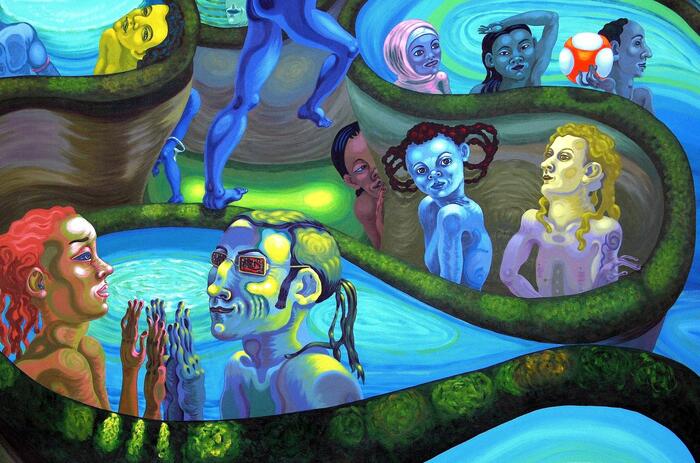
The Museum of Contemporary Art of the Americas presented the exhibition Women Who I Could’ve Been, featuring the latest work of renowned artist Ana Albertina Delgado.
THE MYSTERY OF LIFE IN ANA ALBERTINA DELGADO’S WORK
The Museum of Contemporary Art of the Americas presented the exhibition Women Who I Could’ve Been, featuring the latest work of renowned artist Ana Albertina Delgado.
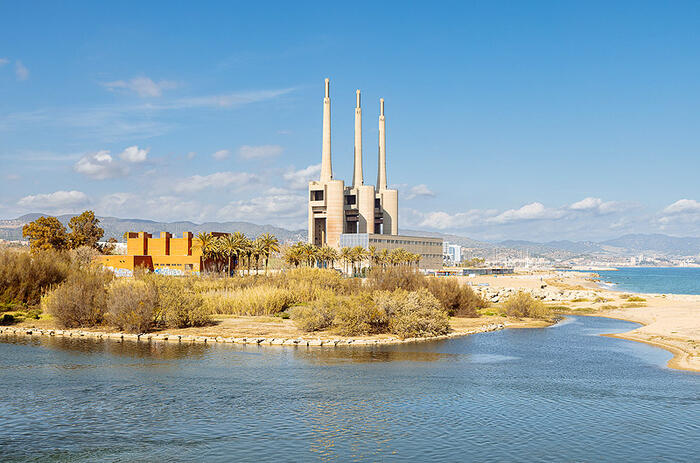
Manifesta, the European nomadic biennial, as it is defined, returns to Spain after past editions in San Sebastian (2004) and Murcia (2010) and will hold its 15th edition in the Metropolitan Area of Barcelona from September 8 to November 24. The multidisciplinary program of actions and exhibitions will be developed around the concept of place and time, focusing, through the exhibition venues chosen in the twelve participating municipalities, on the past, present and future of this region.
THE METROPOLITAN AREA OF BARCELONA HOSTS MANIFESTA 15
Manifesta, the European nomadic biennial, as it is defined, returns to Spain after past editions in San Sebastian (2004) and Murcia (2010) and will hold its 15th edition in the Metropolitan Area of Barcelona from September 8 to November 24. The multidisciplinary program of actions and exhibitions will be developed around the concept of place and time, focusing, through the exhibition venues chosen in the twelve participating municipalities, on the past, present and future of this region.
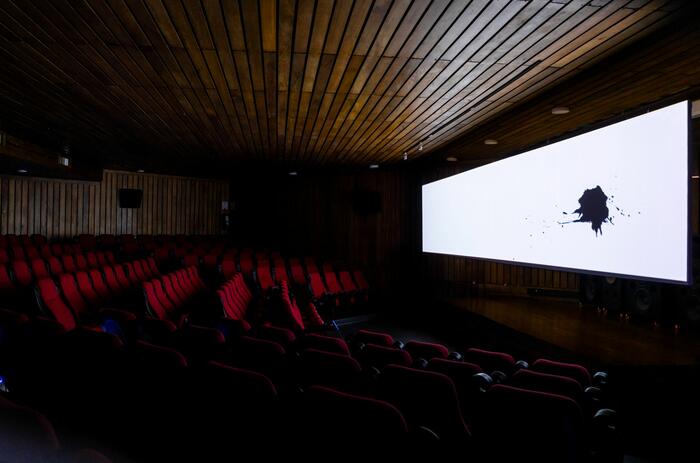
Cronotopías at the Museo de Arte Moderno de Bogotá (MAMBO) is the first institutional retrospective in Colombia dedicated to the visionary work of Argentinean artist Silvia Rivas. Since the late 1990s, Rivas has explored the expressive possibilities of expanded cinema, pushing the boundaries of video as a medium and creating multimedia and immersive environments. The exhibition is curated by Eugenio Viola.
SILVIA RIVAS AND THE LIMITS BETWEEN TIME AND SPACE
Cronotopías at the Museo de Arte Moderno de Bogotá (MAMBO) is the first institutional retrospective in Colombia dedicated to the visionary work of Argentinean artist Silvia Rivas. Since the late 1990s, Rivas has explored the expressive possibilities of expanded cinema, pushing the boundaries of video as a medium and creating multimedia and immersive environments. The exhibition is curated by Eugenio Viola.

Two decades after Miguel Ángel Rojas (1946, Bogotá, Colombia) conceptualized in his project David Quiebramales his denunciation of violence and the use of education as the most efficient vehicle towards a catharsis for those who suffer it, the Madrid headquarters of La Cometa revisits his most emblematic work and reinterprets it as the framework for a kind of thematic retrospective. This commemoration of that first David Quiebramales reinforces a view that is still difficult to overcome and that, even today, serves to trace those harmful social dynamics that are created between society and war, the institutional and the political systems.
TOWARDS MIGUEL ÁNGEL ROJAS' QUIEBRAMALES
Two decades after Miguel Ángel Rojas (1946, Bogotá, Colombia) conceptualized in his project David Quiebramales his denunciation of violence and the use of education as the most efficient vehicle towards a catharsis for those who suffer it, the Madrid headquarters of La Cometa revisits his most emblematic work and reinterprets it as the framework for a kind of thematic retrospective. This commemoration of that first David Quiebramales reinforces a view that is still difficult to overcome and that, even today, serves to trace those harmful social dynamics that are created between society and war, the institutional and the political systems.

Quiebramales commemorates the twentieth anniversary of the conception of the David Quiebramales project. The exhibition at La Cometa gallery revisits the biopolitics that traverse the bodies affected by war, the structures that build (and destroy) a society, and education as a path to social justice.

Nuevos vecinos (New neighbours) seeks to set up a dialogue between the last two projects by Adrián Gaitán: Para los tiempos que corren, presented in the XI version of the Luis Caballero award in 2022 and Nobleza Obliga, carried out in NC arte in 2021.
NUEVOS VECINOS. ADRIAN GAITÁN’S EXHIBITION AT LA COMETA

Concrete Wounds/Herida concreta is the exhibition that the Canary Islands' Centro Atlántico de Arte Moderno (CAAM) is dedicating to Karlo Andrei Ibarra (San Juan, Puerto Rico, 1982), one of the most promising and internationally renowned names of the Puerto Rican art scene.
THE POLITICAL AND SOCIAL MEANINGS OF KARLO ANDREI IBARRA AT CAAM
Concrete Wounds/Herida concreta is the exhibition that the Canary Islands' Centro Atlántico de Arte Moderno (CAAM) is dedicating to Karlo Andrei Ibarra (San Juan, Puerto Rico, 1982), one of the most promising and internationally renowned names of the Puerto Rican art scene.

The birth of a new collective is always good news, and it is so for several reasons. Firstly, because of the existence of collective dynamics that bring together different points of view and, second, because, in a didactic way, it contributes to illustrate and understand the current cartographies of art. For the Revolú collective, formed by Andrés Meléndez (San Juan, Puerto Rico, 1996), Miguel Ángel Feba (San Juan, Puerto Rico, 1994) and Marcos Daniel Vicéns (Bayamón, Puerto Rico, 1996), their first exhibition experience is the result of an artistic residency in which, almost blindly, they have been able to build those specific ties to start from the individual and reach the group identity.
GENESIS AND BORICUA RESONANCES IN REVOLÚ
The birth of a new collective is always good news, and it is so for several reasons. Firstly, because of the existence of collective dynamics that bring together different points of view and, second, because, in a didactic way, it contributes to illustrate and understand the current cartographies of art. For the Revolú collective, formed by Andrés Meléndez (San Juan, Puerto Rico, 1996), Miguel Ángel Feba (San Juan, Puerto Rico, 1994) and Marcos Daniel Vicéns (Bayamón, Puerto Rico, 1996), their first exhibition experience is the result of an artistic residency in which, almost blindly, they have been able to build those specific ties to start from the individual and reach the group identity.

Widline Cadet (Pétion-Ville, Haiti, 1992) brings together in her life experience several of the aspects and themes that, perhaps, have inspired more production among all those curatorial lines with more presence. Her biography, constructed through childhood memories, the environment of a generation and a country marked by its own strong culture or the phenomena of emigration, constitutes the framework in which the photographer develops the practical integrity of her work.
MEMORY AND DIASPORA IN WIDLINE CADET
Widline Cadet (Pétion-Ville, Haiti, 1992) brings together in her life experience several of the aspects and themes that, perhaps, have inspired more production among all those curatorial lines with more presence. Her biography, constructed through childhood memories, the environment of a generation and a country marked by its own strong culture or the phenomena of emigration, constitutes the framework in which the photographer develops the practical integrity of her work.

The Museum of Contemporary Art of the Americas presented the exhibition Women Who I Could’ve Been, featuring the latest work of renowned artist Ana Albertina Delgado.
THE MYSTERY OF LIFE IN ANA ALBERTINA DELGADO’S WORK
The Museum of Contemporary Art of the Americas presented the exhibition Women Who I Could’ve Been, featuring the latest work of renowned artist Ana Albertina Delgado.

Manifesta, the European nomadic biennial, as it is defined, returns to Spain after past editions in San Sebastian (2004) and Murcia (2010) and will hold its 15th edition in the Metropolitan Area of Barcelona from September 8 to November 24. The multidisciplinary program of actions and exhibitions will be developed around the concept of place and time, focusing, through the exhibition venues chosen in the twelve participating municipalities, on the past, present and future of this region.
THE METROPOLITAN AREA OF BARCELONA HOSTS MANIFESTA 15
Manifesta, the European nomadic biennial, as it is defined, returns to Spain after past editions in San Sebastian (2004) and Murcia (2010) and will hold its 15th edition in the Metropolitan Area of Barcelona from September 8 to November 24. The multidisciplinary program of actions and exhibitions will be developed around the concept of place and time, focusing, through the exhibition venues chosen in the twelve participating municipalities, on the past, present and future of this region.

Cronotopías at the Museo de Arte Moderno de Bogotá (MAMBO) is the first institutional retrospective in Colombia dedicated to the visionary work of Argentinean artist Silvia Rivas. Since the late 1990s, Rivas has explored the expressive possibilities of expanded cinema, pushing the boundaries of video as a medium and creating multimedia and immersive environments. The exhibition is curated by Eugenio Viola.
SILVIA RIVAS AND THE LIMITS BETWEEN TIME AND SPACE
Cronotopías at the Museo de Arte Moderno de Bogotá (MAMBO) is the first institutional retrospective in Colombia dedicated to the visionary work of Argentinean artist Silvia Rivas. Since the late 1990s, Rivas has explored the expressive possibilities of expanded cinema, pushing the boundaries of video as a medium and creating multimedia and immersive environments. The exhibition is curated by Eugenio Viola.

Two decades after Miguel Ángel Rojas (1946, Bogotá, Colombia) conceptualized in his project David Quiebramales his denunciation of violence and the use of education as the most efficient vehicle towards a catharsis for those who suffer it, the Madrid headquarters of La Cometa revisits his most emblematic work and reinterprets it as the framework for a kind of thematic retrospective. This commemoration of that first David Quiebramales reinforces a view that is still difficult to overcome and that, even today, serves to trace those harmful social dynamics that are created between society and war, the institutional and the political systems.
TOWARDS MIGUEL ÁNGEL ROJAS' QUIEBRAMALES
Two decades after Miguel Ángel Rojas (1946, Bogotá, Colombia) conceptualized in his project David Quiebramales his denunciation of violence and the use of education as the most efficient vehicle towards a catharsis for those who suffer it, the Madrid headquarters of La Cometa revisits his most emblematic work and reinterprets it as the framework for a kind of thematic retrospective. This commemoration of that first David Quiebramales reinforces a view that is still difficult to overcome and that, even today, serves to trace those harmful social dynamics that are created between society and war, the institutional and the political systems.

Quiebramales commemorates the twentieth anniversary of the conception of the David Quiebramales project. The exhibition at La Cometa gallery revisits the biopolitics that traverse the bodies affected by war, the structures that build (and destroy) a society, and education as a path to social justice.

Nuevos vecinos (New neighbours) seeks to set up a dialogue between the last two projects by Adrián Gaitán: Para los tiempos que corren, presented in the XI version of the Luis Caballero award in 2022 and Nobleza Obliga, carried out in NC arte in 2021.
NUEVOS VECINOS. ADRIAN GAITÁN’S EXHIBITION AT LA COMETA

Concrete Wounds/Herida concreta is the exhibition that the Canary Islands' Centro Atlántico de Arte Moderno (CAAM) is dedicating to Karlo Andrei Ibarra (San Juan, Puerto Rico, 1982), one of the most promising and internationally renowned names of the Puerto Rican art scene.
THE POLITICAL AND SOCIAL MEANINGS OF KARLO ANDREI IBARRA AT CAAM
Concrete Wounds/Herida concreta is the exhibition that the Canary Islands' Centro Atlántico de Arte Moderno (CAAM) is dedicating to Karlo Andrei Ibarra (San Juan, Puerto Rico, 1982), one of the most promising and internationally renowned names of the Puerto Rican art scene.

The birth of a new collective is always good news, and it is so for several reasons. Firstly, because of the existence of collective dynamics that bring together different points of view and, second, because, in a didactic way, it contributes to illustrate and understand the current cartographies of art. For the Revolú collective, formed by Andrés Meléndez (San Juan, Puerto Rico, 1996), Miguel Ángel Feba (San Juan, Puerto Rico, 1994) and Marcos Daniel Vicéns (Bayamón, Puerto Rico, 1996), their first exhibition experience is the result of an artistic residency in which, almost blindly, they have been able to build those specific ties to start from the individual and reach the group identity.
GENESIS AND BORICUA RESONANCES IN REVOLÚ
The birth of a new collective is always good news, and it is so for several reasons. Firstly, because of the existence of collective dynamics that bring together different points of view and, second, because, in a didactic way, it contributes to illustrate and understand the current cartographies of art. For the Revolú collective, formed by Andrés Meléndez (San Juan, Puerto Rico, 1996), Miguel Ángel Feba (San Juan, Puerto Rico, 1994) and Marcos Daniel Vicéns (Bayamón, Puerto Rico, 1996), their first exhibition experience is the result of an artistic residency in which, almost blindly, they have been able to build those specific ties to start from the individual and reach the group identity.

Widline Cadet (Pétion-Ville, Haiti, 1992) brings together in her life experience several of the aspects and themes that, perhaps, have inspired more production among all those curatorial lines with more presence. Her biography, constructed through childhood memories, the environment of a generation and a country marked by its own strong culture or the phenomena of emigration, constitutes the framework in which the photographer develops the practical integrity of her work.
MEMORY AND DIASPORA IN WIDLINE CADET
Widline Cadet (Pétion-Ville, Haiti, 1992) brings together in her life experience several of the aspects and themes that, perhaps, have inspired more production among all those curatorial lines with more presence. Her biography, constructed through childhood memories, the environment of a generation and a country marked by its own strong culture or the phenomena of emigration, constitutes the framework in which the photographer develops the practical integrity of her work.

The Museum of Contemporary Art of the Americas presented the exhibition Women Who I Could’ve Been, featuring the latest work of renowned artist Ana Albertina Delgado.
THE MYSTERY OF LIFE IN ANA ALBERTINA DELGADO’S WORK
The Museum of Contemporary Art of the Americas presented the exhibition Women Who I Could’ve Been, featuring the latest work of renowned artist Ana Albertina Delgado.

Manifesta, the European nomadic biennial, as it is defined, returns to Spain after past editions in San Sebastian (2004) and Murcia (2010) and will hold its 15th edition in the Metropolitan Area of Barcelona from September 8 to November 24. The multidisciplinary program of actions and exhibitions will be developed around the concept of place and time, focusing, through the exhibition venues chosen in the twelve participating municipalities, on the past, present and future of this region.
THE METROPOLITAN AREA OF BARCELONA HOSTS MANIFESTA 15
Manifesta, the European nomadic biennial, as it is defined, returns to Spain after past editions in San Sebastian (2004) and Murcia (2010) and will hold its 15th edition in the Metropolitan Area of Barcelona from September 8 to November 24. The multidisciplinary program of actions and exhibitions will be developed around the concept of place and time, focusing, through the exhibition venues chosen in the twelve participating municipalities, on the past, present and future of this region.

Cronotopías at the Museo de Arte Moderno de Bogotá (MAMBO) is the first institutional retrospective in Colombia dedicated to the visionary work of Argentinean artist Silvia Rivas. Since the late 1990s, Rivas has explored the expressive possibilities of expanded cinema, pushing the boundaries of video as a medium and creating multimedia and immersive environments. The exhibition is curated by Eugenio Viola.
SILVIA RIVAS AND THE LIMITS BETWEEN TIME AND SPACE
Cronotopías at the Museo de Arte Moderno de Bogotá (MAMBO) is the first institutional retrospective in Colombia dedicated to the visionary work of Argentinean artist Silvia Rivas. Since the late 1990s, Rivas has explored the expressive possibilities of expanded cinema, pushing the boundaries of video as a medium and creating multimedia and immersive environments. The exhibition is curated by Eugenio Viola.

Two decades after Miguel Ángel Rojas (1946, Bogotá, Colombia) conceptualized in his project David Quiebramales his denunciation of violence and the use of education as the most efficient vehicle towards a catharsis for those who suffer it, the Madrid headquarters of La Cometa revisits his most emblematic work and reinterprets it as the framework for a kind of thematic retrospective. This commemoration of that first David Quiebramales reinforces a view that is still difficult to overcome and that, even today, serves to trace those harmful social dynamics that are created between society and war, the institutional and the political systems.
TOWARDS MIGUEL ÁNGEL ROJAS' QUIEBRAMALES
Two decades after Miguel Ángel Rojas (1946, Bogotá, Colombia) conceptualized in his project David Quiebramales his denunciation of violence and the use of education as the most efficient vehicle towards a catharsis for those who suffer it, the Madrid headquarters of La Cometa revisits his most emblematic work and reinterprets it as the framework for a kind of thematic retrospective. This commemoration of that first David Quiebramales reinforces a view that is still difficult to overcome and that, even today, serves to trace those harmful social dynamics that are created between society and war, the institutional and the political systems.

Quiebramales commemorates the twentieth anniversary of the conception of the David Quiebramales project. The exhibition at La Cometa gallery revisits the biopolitics that traverse the bodies affected by war, the structures that build (and destroy) a society, and education as a path to social justice.

Nuevos vecinos (New neighbours) seeks to set up a dialogue between the last two projects by Adrián Gaitán: Para los tiempos que corren, presented in the XI version of the Luis Caballero award in 2022 and Nobleza Obliga, carried out in NC arte in 2021.
NUEVOS VECINOS. ADRIAN GAITÁN’S EXHIBITION AT LA COMETA

Concrete Wounds/Herida concreta is the exhibition that the Canary Islands' Centro Atlántico de Arte Moderno (CAAM) is dedicating to Karlo Andrei Ibarra (San Juan, Puerto Rico, 1982), one of the most promising and internationally renowned names of the Puerto Rican art scene.
THE POLITICAL AND SOCIAL MEANINGS OF KARLO ANDREI IBARRA AT CAAM
Concrete Wounds/Herida concreta is the exhibition that the Canary Islands' Centro Atlántico de Arte Moderno (CAAM) is dedicating to Karlo Andrei Ibarra (San Juan, Puerto Rico, 1982), one of the most promising and internationally renowned names of the Puerto Rican art scene.

The birth of a new collective is always good news, and it is so for several reasons. Firstly, because of the existence of collective dynamics that bring together different points of view and, second, because, in a didactic way, it contributes to illustrate and understand the current cartographies of art. For the Revolú collective, formed by Andrés Meléndez (San Juan, Puerto Rico, 1996), Miguel Ángel Feba (San Juan, Puerto Rico, 1994) and Marcos Daniel Vicéns (Bayamón, Puerto Rico, 1996), their first exhibition experience is the result of an artistic residency in which, almost blindly, they have been able to build those specific ties to start from the individual and reach the group identity.
GENESIS AND BORICUA RESONANCES IN REVOLÚ
The birth of a new collective is always good news, and it is so for several reasons. Firstly, because of the existence of collective dynamics that bring together different points of view and, second, because, in a didactic way, it contributes to illustrate and understand the current cartographies of art. For the Revolú collective, formed by Andrés Meléndez (San Juan, Puerto Rico, 1996), Miguel Ángel Feba (San Juan, Puerto Rico, 1994) and Marcos Daniel Vicéns (Bayamón, Puerto Rico, 1996), their first exhibition experience is the result of an artistic residency in which, almost blindly, they have been able to build those specific ties to start from the individual and reach the group identity.

Widline Cadet (Pétion-Ville, Haiti, 1992) brings together in her life experience several of the aspects and themes that, perhaps, have inspired more production among all those curatorial lines with more presence. Her biography, constructed through childhood memories, the environment of a generation and a country marked by its own strong culture or the phenomena of emigration, constitutes the framework in which the photographer develops the practical integrity of her work.
MEMORY AND DIASPORA IN WIDLINE CADET
Widline Cadet (Pétion-Ville, Haiti, 1992) brings together in her life experience several of the aspects and themes that, perhaps, have inspired more production among all those curatorial lines with more presence. Her biography, constructed through childhood memories, the environment of a generation and a country marked by its own strong culture or the phenomena of emigration, constitutes the framework in which the photographer develops the practical integrity of her work.

The Museum of Contemporary Art of the Americas presented the exhibition Women Who I Could’ve Been, featuring the latest work of renowned artist Ana Albertina Delgado.
THE MYSTERY OF LIFE IN ANA ALBERTINA DELGADO’S WORK
The Museum of Contemporary Art of the Americas presented the exhibition Women Who I Could’ve Been, featuring the latest work of renowned artist Ana Albertina Delgado.

Manifesta, the European nomadic biennial, as it is defined, returns to Spain after past editions in San Sebastian (2004) and Murcia (2010) and will hold its 15th edition in the Metropolitan Area of Barcelona from September 8 to November 24. The multidisciplinary program of actions and exhibitions will be developed around the concept of place and time, focusing, through the exhibition venues chosen in the twelve participating municipalities, on the past, present and future of this region.
THE METROPOLITAN AREA OF BARCELONA HOSTS MANIFESTA 15
Manifesta, the European nomadic biennial, as it is defined, returns to Spain after past editions in San Sebastian (2004) and Murcia (2010) and will hold its 15th edition in the Metropolitan Area of Barcelona from September 8 to November 24. The multidisciplinary program of actions and exhibitions will be developed around the concept of place and time, focusing, through the exhibition venues chosen in the twelve participating municipalities, on the past, present and future of this region.

Cronotopías at the Museo de Arte Moderno de Bogotá (MAMBO) is the first institutional retrospective in Colombia dedicated to the visionary work of Argentinean artist Silvia Rivas. Since the late 1990s, Rivas has explored the expressive possibilities of expanded cinema, pushing the boundaries of video as a medium and creating multimedia and immersive environments. The exhibition is curated by Eugenio Viola.
SILVIA RIVAS AND THE LIMITS BETWEEN TIME AND SPACE
Cronotopías at the Museo de Arte Moderno de Bogotá (MAMBO) is the first institutional retrospective in Colombia dedicated to the visionary work of Argentinean artist Silvia Rivas. Since the late 1990s, Rivas has explored the expressive possibilities of expanded cinema, pushing the boundaries of video as a medium and creating multimedia and immersive environments. The exhibition is curated by Eugenio Viola.

Two decades after Miguel Ángel Rojas (1946, Bogotá, Colombia) conceptualized in his project David Quiebramales his denunciation of violence and the use of education as the most efficient vehicle towards a catharsis for those who suffer it, the Madrid headquarters of La Cometa revisits his most emblematic work and reinterprets it as the framework for a kind of thematic retrospective. This commemoration of that first David Quiebramales reinforces a view that is still difficult to overcome and that, even today, serves to trace those harmful social dynamics that are created between society and war, the institutional and the political systems.
TOWARDS MIGUEL ÁNGEL ROJAS' QUIEBRAMALES
Two decades after Miguel Ángel Rojas (1946, Bogotá, Colombia) conceptualized in his project David Quiebramales his denunciation of violence and the use of education as the most efficient vehicle towards a catharsis for those who suffer it, the Madrid headquarters of La Cometa revisits his most emblematic work and reinterprets it as the framework for a kind of thematic retrospective. This commemoration of that first David Quiebramales reinforces a view that is still difficult to overcome and that, even today, serves to trace those harmful social dynamics that are created between society and war, the institutional and the political systems.

Quiebramales commemorates the twentieth anniversary of the conception of the David Quiebramales project. The exhibition at La Cometa gallery revisits the biopolitics that traverse the bodies affected by war, the structures that build (and destroy) a society, and education as a path to social justice.

Nuevos vecinos (New neighbours) seeks to set up a dialogue between the last two projects by Adrián Gaitán: Para los tiempos que corren, presented in the XI version of the Luis Caballero award in 2022 and Nobleza Obliga, carried out in NC arte in 2021.
NUEVOS VECINOS. ADRIAN GAITÁN’S EXHIBITION AT LA COMETA

Concrete Wounds/Herida concreta is the exhibition that the Canary Islands' Centro Atlántico de Arte Moderno (CAAM) is dedicating to Karlo Andrei Ibarra (San Juan, Puerto Rico, 1982), one of the most promising and internationally renowned names of the Puerto Rican art scene.
THE POLITICAL AND SOCIAL MEANINGS OF KARLO ANDREI IBARRA AT CAAM
Concrete Wounds/Herida concreta is the exhibition that the Canary Islands' Centro Atlántico de Arte Moderno (CAAM) is dedicating to Karlo Andrei Ibarra (San Juan, Puerto Rico, 1982), one of the most promising and internationally renowned names of the Puerto Rican art scene.

The birth of a new collective is always good news, and it is so for several reasons. Firstly, because of the existence of collective dynamics that bring together different points of view and, second, because, in a didactic way, it contributes to illustrate and understand the current cartographies of art. For the Revolú collective, formed by Andrés Meléndez (San Juan, Puerto Rico, 1996), Miguel Ángel Feba (San Juan, Puerto Rico, 1994) and Marcos Daniel Vicéns (Bayamón, Puerto Rico, 1996), their first exhibition experience is the result of an artistic residency in which, almost blindly, they have been able to build those specific ties to start from the individual and reach the group identity.
GENESIS AND BORICUA RESONANCES IN REVOLÚ
The birth of a new collective is always good news, and it is so for several reasons. Firstly, because of the existence of collective dynamics that bring together different points of view and, second, because, in a didactic way, it contributes to illustrate and understand the current cartographies of art. For the Revolú collective, formed by Andrés Meléndez (San Juan, Puerto Rico, 1996), Miguel Ángel Feba (San Juan, Puerto Rico, 1994) and Marcos Daniel Vicéns (Bayamón, Puerto Rico, 1996), their first exhibition experience is the result of an artistic residency in which, almost blindly, they have been able to build those specific ties to start from the individual and reach the group identity.

Widline Cadet (Pétion-Ville, Haiti, 1992) brings together in her life experience several of the aspects and themes that, perhaps, have inspired more production among all those curatorial lines with more presence. Her biography, constructed through childhood memories, the environment of a generation and a country marked by its own strong culture or the phenomena of emigration, constitutes the framework in which the photographer develops the practical integrity of her work.
MEMORY AND DIASPORA IN WIDLINE CADET
Widline Cadet (Pétion-Ville, Haiti, 1992) brings together in her life experience several of the aspects and themes that, perhaps, have inspired more production among all those curatorial lines with more presence. Her biography, constructed through childhood memories, the environment of a generation and a country marked by its own strong culture or the phenomena of emigration, constitutes the framework in which the photographer develops the practical integrity of her work.

The Museum of Contemporary Art of the Americas presented the exhibition Women Who I Could’ve Been, featuring the latest work of renowned artist Ana Albertina Delgado.
THE MYSTERY OF LIFE IN ANA ALBERTINA DELGADO’S WORK
The Museum of Contemporary Art of the Americas presented the exhibition Women Who I Could’ve Been, featuring the latest work of renowned artist Ana Albertina Delgado.

Manifesta, the European nomadic biennial, as it is defined, returns to Spain after past editions in San Sebastian (2004) and Murcia (2010) and will hold its 15th edition in the Metropolitan Area of Barcelona from September 8 to November 24. The multidisciplinary program of actions and exhibitions will be developed around the concept of place and time, focusing, through the exhibition venues chosen in the twelve participating municipalities, on the past, present and future of this region.
THE METROPOLITAN AREA OF BARCELONA HOSTS MANIFESTA 15
Manifesta, the European nomadic biennial, as it is defined, returns to Spain after past editions in San Sebastian (2004) and Murcia (2010) and will hold its 15th edition in the Metropolitan Area of Barcelona from September 8 to November 24. The multidisciplinary program of actions and exhibitions will be developed around the concept of place and time, focusing, through the exhibition venues chosen in the twelve participating municipalities, on the past, present and future of this region.

Cronotopías at the Museo de Arte Moderno de Bogotá (MAMBO) is the first institutional retrospective in Colombia dedicated to the visionary work of Argentinean artist Silvia Rivas. Since the late 1990s, Rivas has explored the expressive possibilities of expanded cinema, pushing the boundaries of video as a medium and creating multimedia and immersive environments. The exhibition is curated by Eugenio Viola.
SILVIA RIVAS AND THE LIMITS BETWEEN TIME AND SPACE
Cronotopías at the Museo de Arte Moderno de Bogotá (MAMBO) is the first institutional retrospective in Colombia dedicated to the visionary work of Argentinean artist Silvia Rivas. Since the late 1990s, Rivas has explored the expressive possibilities of expanded cinema, pushing the boundaries of video as a medium and creating multimedia and immersive environments. The exhibition is curated by Eugenio Viola.




